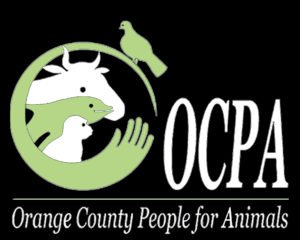Animal fur used to be thought of as a luxury garment, but public opinion is changing as more people become aware of the abuse and torture fur-bearing animals are forced to endure. From trapping to fur farms and the annual seal “hunt,” killing animals for their fur, features and / or skins and hides is a barbaric and unnecessary practice.
Each year, more than tens of millions of animals are killed for their fur: mink, fox, bobcat, beavers, raccoon, lynx, chinchilla, coyote, fisher, marten, muskrat, opossum, otter, skunk, weasel, seals, rabbits, wolves, bears, cats, dogs, rabbits — the list goes on and on.
Each piece of fur trim represents an animal who suffered and died; a full coat represents many animals. It takes the following number of animals to make one 40-inch coat: 16 coyote, 18 lynx, 60 mink, 45 opossum, 20 otter, 42 red fox, 40 raccoon, 50 sable, 8 seal, 50 muskrat and 15 beaver.
And then there are the animals who are raised and abused and / or killed for their feathers, wool and/or skin like ducks, geese, cows, sheep, and alligators – all in the name of fashion.
Over the last several years, prominent designers such as Calvin Klein and Bill Blass have shown compassion and removed fur from their garments, and hundreds of celebrities have announced that they won’t be caught dead wearing fur. Instead, as more and more people learn about the cruelty behind the fur industry, they are opting to wear faux animal fur / feathers / skin instead.
Fur trapping is a barbaric activity, done to supply people with an object of vanity, a fur coat. Clearly this animal suffering cannot be justified with such a frivolous end product.
The primary tools used by fur trappers are the following: leghold trap, the body grip (Conibear) trap, and the wire snare.
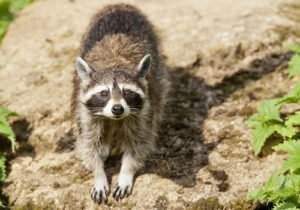 While causing extensive injury, leghold traps are not designed to kill an animal outright, but rather to restrain it until the trapper returns. Animals suffer for days in steel-jawed leghold traps before being killed by one of a variety of methods: standing on their chests to crush their lungs, shooting them, clubbing them, stabbing them, or by other equally cruel methods. Some leghold traps are actually set in a way as to kill an animal as opposed to restrain it. Set in the water and called “drowning sets,” these are mostly reserved for beaver, muskrat, and mink.
While causing extensive injury, leghold traps are not designed to kill an animal outright, but rather to restrain it until the trapper returns. Animals suffer for days in steel-jawed leghold traps before being killed by one of a variety of methods: standing on their chests to crush their lungs, shooting them, clubbing them, stabbing them, or by other equally cruel methods. Some leghold traps are actually set in a way as to kill an animal as opposed to restrain it. Set in the water and called “drowning sets,” these are mostly reserved for beaver, muskrat, and mink.
State laws vary in regards to how long an animal can be left in a trap. Some states have no time limits, others mandate that traps be checked every 72 hours, 36 hours, etc. Some animals in traps will be found dead from dehydration, blood loss, hypothermia, or other trap inflicted injuries. Many animals are eaten by predators that find them helpless in these traps.
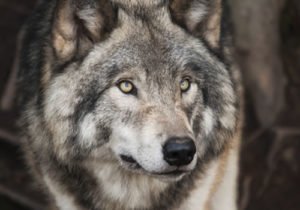 Thousands of animals, referred to by the fur industry as “trash animals,” are also caught in traps every year, including birds, reptiles, squirrels, dogs, cats and sometimes even children.
Thousands of animals, referred to by the fur industry as “trash animals,” are also caught in traps every year, including birds, reptiles, squirrels, dogs, cats and sometimes even children.
The leghold trap has been banned in eighty-eight countries, but only nine states in the U.S. have passed legislation to ban or restrict the use of steel-jaw traps.
Fur-farming methods are designed to maximize profits at the expense of the animal’s health and comfort. For example, foxes are kept in tiny wire cages up to two feet square with up to four animals per cage. Likewise, minks suffer from close confinement, often developing self-mutilating behaviors. The animals in these concentration camp conditions also exhibit distressed neurotic behaviors such as pacing back and forth in their cages.
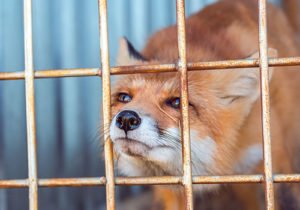 Animals live in filth on fur farms and are often victims of disease and pests; only minimal survival needs are met. Animals on fur ranches are killed by a variety of methods, including anal electrocution, where a metal rod is inserted into the anus as the animal is forcibly held down.
Animals live in filth on fur farms and are often victims of disease and pests; only minimal survival needs are met. Animals on fur ranches are killed by a variety of methods, including anal electrocution, where a metal rod is inserted into the anus as the animal is forcibly held down.
Under normal circumstances, minks spend about 70 percent of their time in water. But on fur farms, where little water is available, their salivation, respiration, and body temperatures increase to unnatural and painful levels. A large number of minks die on American fur farms due to heat stress alone.
There are no regulations protecting animals on fur ranches. Cages are typically kept in open sheds that provide little protection from wind, cold, or heat. In the winter, animals often have to endure sub-zero temperatures, and are unable to cool their bodies with water during the summer heat.
More than 85 percent of pelts used in the world’s fur trade come from small, family-run farms. Recognizing the cruelty inherent in the fur factory farming system, Austria, Croatia, the United Kingdom, Czech Republic and Norway have banned fur farms. In The U.S., there are still about 275 mink farms in 23 states that kill approximately three million mink every year. Since the American government does not regulate fur farming and that the states do not force fur ranchers to comply with existing cruelty statutes at this time, severe abuses occur.
Two marine mammal species that are threatened in large numbers are the Canadian harp seal and the hooded seal. Expanding and unregulated trade in seal products (mostly fur) is causing this threat.
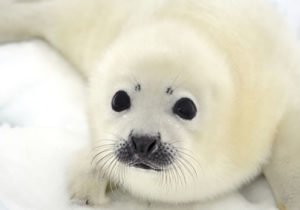 Harp seals suffer the largest slaughter annually of any marine mammal species. During Canada’s annual seal hunt, fishermen kill harp seal pups by using wooden clubs, hakapiks (large ice-pick-like clubs) and guns. Ninety-seven percent of the harp seals killed are pups under just three months of age, and nearly half of them are skilled while still alive.
Harp seals suffer the largest slaughter annually of any marine mammal species. During Canada’s annual seal hunt, fishermen kill harp seal pups by using wooden clubs, hakapiks (large ice-pick-like clubs) and guns. Ninety-seven percent of the harp seals killed are pups under just three months of age, and nearly half of them are skilled while still alive.
Despite the worldwide public outcry against this cruel and barbaric practice, more than one million seals have been slaughtered in the past five years alone – the highest kill rates set since the 1960s.



